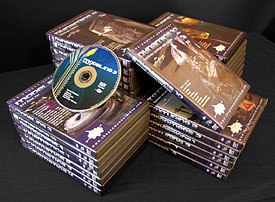Sarah Baisley looks at the boom in new training products to help artists hone new skills for an ever-changing industry.

Schools and studios are getting into the educational products business. While only a few have jumped into the game, it wont be long before others discover what can be a welcome revenue stream.
With the cutbacks at animation studios producing television series and features in North America, as well as harder economic times, those seeking employment are advised to freshen up their job skills. Plus many animators and production people are finding they need to transition from 2D to 3D. So there is a boom in animation education/training and the need for products to help students practice or even learn on their own at home via products and online courses.
The increase in software and hardware products plus the steady stream of updated versions has been accompanied for some time now by instructional manuals, books, videos, CD-ROMs and DVDs. Its a nice additional revenue stream for the manufacturers of software/hardware and given rise to companies specializing in distributing books and products.
Animation World Magazine caught up with a few of the institutions and studios that have grown wise to this and are making forays into the field of educational products to augment income for their core business.
The Vancouver Institute of Media Arts in Canada launched a series of online lessons and lectures featuring the late Academy Award-winning animator, Lee Mishkin, offering lessons he developed with the faculty for the VanArts Classical Animation Program. Not a bad idea for preserving the inspiration and ideas future generations might draw from inspiring teachers and important animators, even after they are gone.


Late Academy Award-winning animator, Lee Mishkin (left). Alan Phillips, president/registrar at VanArts. Photo courtesy of VanArts.
We started thinking about distance education/online training around 1997, said Alan Phillips, president/registrar at Van Arts. The initial idea was to create high-quality animation education product that would reach several markets, from wannabe animators to educators to industry people getting back to basics. To accomplish this, we created the Lee Mishkin Lecture Series and online animation lessons. Lee was the founding director of VanArts classical animation program and a highly acclaimed Hollywood animator with five decades of experience and an Academy-Award winning film.
After VanArts launched the lecture series and initial online lesson, The Bouncing Ball, Phillips said, We are encouraged by the growing worldwide interest and orders we have received to date. The bouncing ball lesson was prepared by Lee Mishkin and other senior faculty in consultation with the University of British Columbia, Distance Education & Technology Unit. To view sample video clips from the lecture series or bouncing ball lesson, please visit www.vanarts.com/online/index.htm.
The course is structured so that students develop the ability to create drawings that are living, breathing characters behaving in distinctly personalized ways on screen. Lessons in the series cover the basic principles of classical animation including the bouncing ball, inbetweening, sack jump, character design, action analysis and the walk cycle.

Gnomon School of Visual Effects, a professional institute specializing in training for the high-end visual effects community in Los Angeles has also gotten into online training and has released an impressive series of training DVDs. Gnomon has created a division Gnomon Workshop, an online resource for the Maya community produces training DVDs and free tutorials.
A recent Gnomon Workshop release, Dynamics, 14: Advanced Sprite Rendering, includes 120 minutes of instruction, project files, lecture notes, resource spotlights and bonus materials. The DVD was produced by Andrew Orloff, principal and vfx supervisor at Zoic Studios. The DVD explains the tools, with a focus on workflow, using a wide range of examples including wind-blown seedpods, a sea of microbes, depth-of-field effects, tossed coins and crowd simulations.
We are very excited to have produced such an in-depth lecture, said Alex Alvarez, director of the Gnomon Workshop. Andrew is an industry veteran who has played the role of artist, technical director and now vfx supervisor. He is also an excellent instructor, who, through this DVD, is sharing several techniques that have been used is a diverse range of visual effects shots over his career.
The Gnomon Workshop also just released four new training DVDs by concept designer Feng Zhu. Focused on the traditional and digital techniques of the concept design industry, these four titles contain more than eight hours of instruction. Fengs clients include Lucasfilm, Disney, Blur Studio, Electronic Arts, GT Interactive, Origin Systems, Microsoft, Film Roman, Universal, Warner Bros. and Sierra.
Alex Alvarez approached me about making some DVDs almost a year ago, said Zhu. At the time, I was just leaving for Lucasfilm, so it never materialized. Once I returned to L.A., however, we decided to get it produced. I had a lot of fun working on them. I thought about what a student would want to see, and put as much as I could into these DVDs.
More information and prices for Gnomons DVDs are available at www.thegnomonworkshop.com.

Canadian animation studio Lost Pencil Animation Studios Inc. now makes educational products to pump up its revenue and to provide work to employees when projects are scarce. It was founded in Calgary in 1996 as a graphic design studio with just a couple people in-house, with access to other talented artists when the need arises. Then they moved into multimedia and the studio grew.
Thats when the 3D bug got us, said co-founder Paul Mikulecky. As we gained experience in 3D, we slowly weaned ourselves off of the print and Web work. Now our mainstay is freelance character animation for other studios. Our character animations can be found in video, TV and games. Some of Lost Pencils clients include Absolute Studios, Sony, Fox, Aurenya, HyperSpace Cowgirls and Blue Dream Studios.
At one point, about a year and a half ago, we had a lull. Well, bills needed to be paid and animators/modelers were without work. So we had to either spend time drumming up more work (in the other fields, Web, multimedia and print) or decide on something else.
I had previously been teaching an introductory graphic design course at the University of Calgary, and thats when the thought occurred to me, Mikulecky continued. Producing training material would enable us to learn more tools (keep us busy), improve our work (practice makes perfect) and pay the bills.

So Lost Pencil ramped up its first product, Animators Gym, a CD that teaches basic principles of character animation and a walkthrough of the creation of a one-minute short. It is created using Maya, but we encourage other tool users to purchase it as it is only about 25% software specific, said Mikulecky. Initially we planned on specializing on training material for just character animation. But we found that we had a lot of requests, not just for the character animation training, but also the other aspects of the 3D workflow. This made us branch into the modeling/rigging and texturing fields.
With this good reception, Lost Pencil has added a number of other titles to its educational products list. These include a training series for LightWave, 3ds max and Maya. Our biggest seller so far has been the 3D Apprenticeship training series which covers a step-by-step creation of a realistic elephant in Maya, Mikulecky reports. This training series included modeling the elephant, rigging it, texturing it and animating it doing a walk cycle. We are working on a similar product for 3ds max (except it wont be an elephant), which should be available by the end of November 2003. Lost Pencil also gives away free tutorials, free models and rigs on its Website, www.lostpencil.com.
Mikulecky said he believes his studios training series is unique, covering every step of the process, from the perspective of hands-on production people and animators, as opposed to educators and software developers/programmers. You can watch everything being created step by step with the artist narrating the process, he said. We dont strive to cover every detail of the tool (or all the options for a tool that we may use), but we give students the process that we use to create production animation for our clients.

The training material isnt meant to replace the manuals or other training products that give a tool overview from the developer/manufacturer. In order to use Lost Pencils CDs, students must have an introductory familiarity with the tool. The studio claims the material can be useful for beginning to advanced users.
The training material generally is available on CDs, but in some cases DVDs are available. The DVDs are not viewable on a regular video DVD player and can only be viewed on a PC (some can be viewed on a Mac). Source files for the animations, models, rigs and textures are all provided so students can compare their result with the studios completed files.
The Lost Pencil product line includes:
For LightWave: Just Animate - Walk Cycles Just Animate - Lip Sync Just Animate - Facial Expressions and Body Language Just Animate - Games! Model and Rig in a Day!
For 3ds max: Just Animate - Walk Cycles 3D Apprenticeship Series (planned for end of November 2003, it will have a similar line up to the 3D Apprenticeship series for Maya below)
For Maya: Animators Gym Just Animate Wheels (this is a free tutorial available for the price of shipping only) 3D Apprenticeship - Modeling 3D Apprenticeship - UV Mapping and Texturing 3D Apprenticeship - Rigging and Weightmapping 3D Apprenticeship - Animation and Render

Supporting its short film habit with products is Anzovin Studio. Anzovin was founded in 1998 in Amherst, Massachusetts by the father-and-son team of Steve and Raf Anzovin to create 3D animated short films with a sophisticated and lively sense of humor. The studio offers custom 3D design and modeling services, character animation and motion graphics for broadcast, as well as innovative cross-platform animation software solutions and animation training products.
Anzovin is a leading publisher of training materials for Hashs Animation:Master 3D animation software, has released a new instructional CD-ROM, Secrets Of Animation:Master 2003. Anzovins Raf Anzovin and Bill Young take viewers step by step through some of the newest and least understood features of A:M 2003 (version 10/10.5). It features more than two hours of pristine, 800x600 QuickTime video and all associated project files, models and rotoscopes. Topics include using deformation cages, working with expressions to create automated animation, using displacement textures to create water effects and Bill Anzovin s latest spriticle tricks. Secrets Of Animation:Master 2003 is compatible with Windows and Mac. It can be ordered from the Anzovin Studio Store at www.rafhashvideotapes.com.
Anzovin also recently released The Setup Machine for Maya 5.0, a character rigging plug-in fully compatible with the latest version of Mayas animation environment. The Setup Machine for Maya 5.0 can be ordered from www.anzovin.com/setupmachine/setupmachinemaya.html.
With the advent of more online learning and the growing need to compete and transition in the rapidly changing arenas of animation and visual effects, more educational institutions plan to enter the educational products field. Plus studios are finding they can teach what they do to make money and support their animated dreams.
Sarah Baisley is the editor of Animation World Network.








